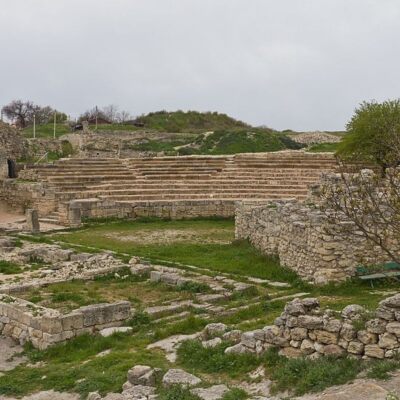Chapters
In Ukraine, we can find remains of the presence of ancient Romans, as well as evidence of intimate trade contacts with peoples inhabiting the Ukrainian steppes – Sarmatians or Scythians. One of the most abundant Roman finds is the Crimean Peninsula.
The presence of the Romans in Crimea
In the region of Sevastopol (southwest of Crimea), in antiquity, there was a commercial city-state Tauridian Chersonesus (Chersonesus), which was founded in the 6th century BCE by Greek settlers. Chersonesos took over the western part of Crimea and became the main centre for the spread of Greek culture and trade cooperation with barbarian tribes. With the advent of the Scythian threat, Chersonesos came under the influence of Pontus after he turned for help.
After Mithridates’ defeat in the 1st century BCE war with Rome, Chersonesos gradually became dependent on the Roman Empire in the 1st century BCE. The official presence of the Romans is possible from the time of the reign of Emperor Nero (54-68 CE) when Chersonesos was supported in repelling the Scythian attack. In the 1st-2nd century CE, a contingent of Roman troops was established in the city, as well as in other cities of southern Crimea, where the Romans expanded and modernized fortifications. The emergence of Roman influence in Crimea brings the period of the re-flowering of Chersonesos. Although Crimea was not a province of the Empire, it was within its sphere of influence.
We can define the end of the presence of the Romans in Crimea in the middle of the 3rd century CE when there was a great migration of peoples and the appearance of the Goths.
Chersonesos
The remains of the ancient city of Chersonesos are located near Sevastopol, west of the city. Chersonesos was a city influenced by Greek, Roman and Byzantine cultures successively.
After falling under Roman influence, the city began to prosper again. The Greek theatre located in the city was transformed into an amphitheatre, where gladiator fights took place. The Romans also built a citadel with powerful fortifications in Chersonesos, barracks for soldiers, and administrative buildings and temples. Outside the city walls, traces of wine presses, agricultural activities, free-standing defensive towers and necropolises were also found. Additionally, numerous finds from various periods of the city’s existence were discovered in the city; including numerous coins, ceramics, and mosaics.
Chersonesos was surrounded by walls over 3 km long, about 4 meters wide and 8 meters high. The walls had towers 10 meters high.
Roman camp in Charax
On the southern coast of Crimea, there are remains of the only Roman military camp discovered so far. It was located in Charax and existed between the 1st and 3rd centuries CE. The Roman fort was built on the site of the former Taurian settlement, an Iranian tribe that originally inhabited this area. The Roman camp was established in Charax during the reign of Vespasian (69-79 CE).
The camp consisted of two defensive walls: the outer one covered an area of 6 hectares; the internal 2 hectares. The camp in total was able to accommodate a detachment (vexillatio) of 500 soldiers, and mainly the legions I Italica and XI Claudia was stationed here. The Charax camp was of strategic importance for the Romans, as it protected Crimea from the south against the Scythian and Sarmatian invasions.
Charax camp had warehouses, thermal baths, swimming pools, gymnasiums and waterworks that allowed it to withstand long sieges. Archaeologists also discovered the foundations of the houses and the Roman temple.
Traces in areas other than Crimea
The presence of the Romans on the Crimean Peninsula meant that economic and cultural relations with the peoples inhabiting the remaining areas of today’s Ukraine were developing. The Romans based their influence mainly on the Crimean coast and more important former Greek centres. Barbarian agricultural products were imported into ports and coastal settlements under Roman control, in return offering weapons, materials, ceramics, jewellery and other goods.
Roman merchants were certainly also going deep into Ukraine, as evidenced by the numerous Roman coins discovered in various parts of the country. In total, over 1,000 Roman discoveries were made in Ukraine, and larger treasures were found hidden in 137 places. In addition to coins, researchers found many Roman objects of everyday use or related to the religion of the Romans.
Scientists believe that the Roman silver denarius was the main currency in Ukraine between the 2nd and 5th centuries CE.









